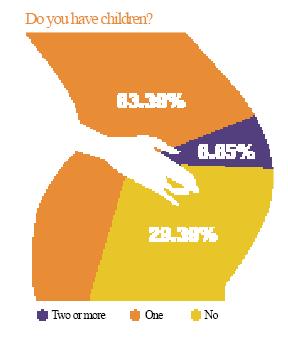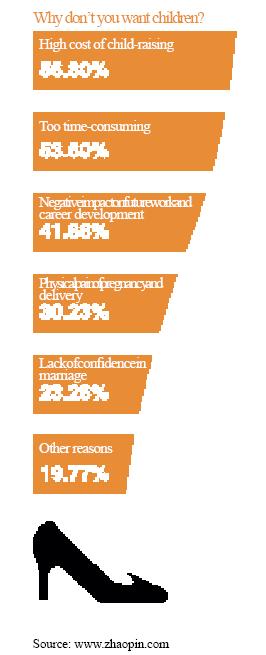Since China abandoned its four-decade family planning policy in 2016, commonly referred to as the one-child policy, allowing all couples to have two children, the growth in the nation’s fertility rate has been far lower than the government expected. Data from the National Bureau of Statistics shows the birth rate declined from 17.86 million births in 2016 to 17.23 million in 2017 – 630,000 fewer newborns, a drop of 3.5 percent.
To encourage families to have more children, many local governments have come up with incentives in recent years. Lively discussions, and sometimes controversial suggestions in academic circles about approaches to boosting the birth rate, have often spilled over onto social media, sparking quite vehement opposition.
In mid-August, two professors from Nanjing University in Jiangsu Province published an article in a local government newspaper which proposed a “fertility fund” – paid for by taxing people under the age of 40 – which would subsidize families if they had a second child.
The article drew widespread scorn from the public, media and fellow academics. The proposal was slammed for being unworkable, and described as “improper,” “unreasonable,” and even “stupid.” It would be a drastic shift from “forcing people to have fewer children” to “forcing people to have more children,” some said. Yet sociologist Huang Kuangshi, assistant professor at the China Population and Development Research Center said that with a few tweaks, the fertility fund idea could be an effective policy incentive. In an interview with NewsChina, Huang agreed that an adjusted fertility fund could be a viable solution, although he believes other incentives may be more practical.
NewsChina: What do you think about the recent suggestion of a fertility fund to boost the birth rate?
Huang Kuangshi: A fertility fund, if it’s only paid into by the general public, is not a practical and reasonable policy suggestion. However, we could make a very sound policy out of this.
First, a fertility fund must be a combined responsibility of the family and the employer, as well as the government. It could operate like the housing fund, where an individual, their employer and the government could contribute the same proportion. So in this way, the responsibilities of the three sides would be fully represented. Secondly, the family starts getting money from the fund when they have a child, the same way people now get money from the housing fund when they buy or rent a house. If you don’t have a child, you could get the contributions back after you retire. Third, with the fertility fund, families could benefit from preferential policies if they need loans to help with the cost of bringing up children. And last, if you have a second child, you’d get more money from the fund, so the government and employer would increase their support.
NC: What benefits would an individual get from a fertility fund?
HK: The fund would involve transferring part of your personal salary into it, and when you have a child, he or she could withdraw the money any time they want. In addition, with the government and the employer’s contributions to the fund, it will be a way to increase personal income. More importantly, just like the housing fund, you could get preferential rates on bank loans to contribute to bringing up your children.
In the present situation, society should encourage academics to voice their opinions. Some, who are not professionals in this field, are giving suggestions which may be wide of the mark, but we could use them as a stepping-off point for further studies by professional demographers and other experts.
NC: You have also suggested certain tax policies to encourage childbearing. What are they?
HK: I have made proposals to the National People’s Congress on personal tax reform. Now I firmly believe it is high time to use personal tax reductions as an incentive to boost the population, rather than setting up a fertility fund.
For example, with a monthly tax reduction of 1,000 yuan (US$146) for each child in a family, the total annual tax reduction for one child is up to 12,000 yuan (US$1,758). So if you have two children, you could get a reduction of up to 480,000 yuan (US$70,336) over 20 years. This kind of policy could also help ensure timely registration and data collection for newborns, which is very important for population monitoring and to ensure prosperity for families.
NC: Some people believe it is not yet time for large-scale childbearing subsidies in light of the over-burdened national finance system and the huge gap in the pension fund. What’s your view?
HK: Looking at the current situation, there’s no urgency to implement a large-scale subsidy system yet. We still need careful research and evaluation on what the effects would be of different childbearing subsidies or maternity allowance policies. But from a long-term perspective, subsidies will be necessary to increase the birth rate.
NC: Staring in 2017, many local governments, including some cities in Hubei Province, have launched policies to encourage families to have a second child. What do you think of these incentives?
HK: As you said, local governments in Hubei have tried ways to encourage more families to have a second child. These include encouraging businesses to allow longer maternity leave of up to six months; giving a childbirth subsidy of 1,200 to 2,500 yuan (US$176-366); providing a 1,000 yuan (US$147) annual subsidy for kindergarten education for a second child; and setting up mother-and-baby rooms in public places.
According to figures from the Hubei provincial government, in 2017, the fertility rate was 12.6 percent and the natural population growth rate [ratio of birth surplus or deficit to total population] was 5.59 percent. There were 742,600 babies born in the province. The proportion of local over-60s was 18.77 percent of the total provincial population, higher than the national average.
It’s a good thing if local governments set up incentive policies. With local differences across the country, it isn’t really possible to have a one-size-fits-all national policy. It’s a good option to allow local governments to trial policies and observe the effects and what deficiencies might occur during the process.
NC: What is the trend of the future population policy in China and do you think there will be national incentive policies to boost childbirth within the year?
HK: Encouraging childbirth is a natural result of economic and social development [when the birth rate will inevitably drop]. Without incentives, the national population will not collapse and we don’t need to worry about the demise of a nation. However, incentives are necessary to help people find the balance between family and work and enhance working efficiency. They will also be a good way to foster the next generation, thus improving the national quality of the population as a whole.

 Old Version
Old Version

